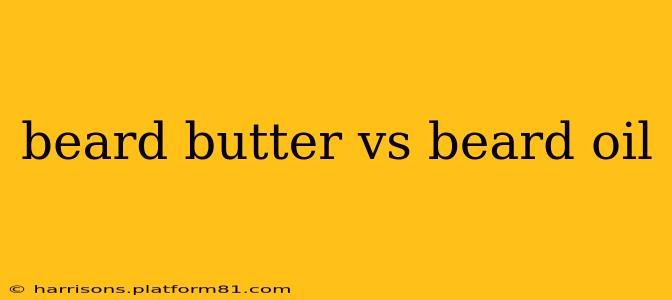Choosing between beard butter and beard oil can feel like navigating a dense forest of facial hair products. Both aim to soften, condition, and style your beard, but they achieve this through different mechanisms, making them better suited for different beard types and needs. This comprehensive guide will break down the key differences, helping you determine which product will best tame your mane.
What is Beard Butter?
Beard butter is a thicker, more emollient product than beard oil. It's typically a blend of natural butters (like shea butter, mango butter, or cocoa butter), oils (often lighter oils like jojoba or grapeseed oil), and sometimes beeswax or other natural waxes for added hold. This combination creates a creamy, often slightly whipped consistency that provides deep conditioning and moisture. Think of it as a richer, more intense moisturizer for your beard and the skin underneath.
What is Beard Oil?
Beard oil, on the other hand, is a lighter product consisting primarily of carrier oils (such as argan oil, almond oil, or coconut oil) and sometimes essential oils for fragrance. Its liquid nature allows for easy absorption, making it ideal for moisturizing both the beard hair and the underlying skin. It's less heavy than beard butter, providing a softer, less noticeable feel.
Beard Butter vs. Beard Oil: A Head-to-Head Comparison
| Feature | Beard Butter | Beard Oil |
|---|---|---|
| Consistency | Thick, creamy, whipped | Liquid, oily |
| Absorption | Slower, leaves a noticeable residue | Faster, absorbs readily |
| Moisture | High, provides intense conditioning | Moderate, good for daily hydration |
| Hold | Moderate to high, depending on ingredients | Minimal |
| Scent | Can be stronger, due to added ingredients | Can be subtle or strong, depending on oils |
| Best for | Thicker, coarser, dry beards; styling | All beard types, particularly finer beards |
| Frequency of Use | Can be used less frequently (2-3 times a week) | Can be used daily, or as needed |
What are the benefits of using beard butter?
Beard butter offers several key advantages:
- Deep Conditioning: Its rich formulation provides intense hydration and nourishment, ideal for coarse or dry beards.
- Styling: The added butters and waxes offer a degree of hold, helping to shape and style your beard.
- Skin Protection: It acts as a protective barrier against harsh environmental elements.
- Reduced Itch: By deeply moisturizing the skin underneath the beard, it can significantly reduce itchiness and irritation.
What are the benefits of using beard oil?
Beard oil boasts its own set of benefits:
- Hydration: It effectively moisturizes both the beard hair and the underlying skin, preventing dryness and breakage.
- Softness: It leaves the beard feeling soft, smooth, and manageable.
- Growth Stimulation: Some oils are believed to promote healthy beard growth.
- Lightweight Feel: It's less heavy than beard butter, making it ideal for daily use without feeling greasy.
Which is better for different beard types?
- Short, Fine Beards: Beard oil is generally preferred for shorter, finer beards as it won't weigh them down.
- Long, Coarse Beards: Beard butter is a better choice for longer, thicker, or coarser beards needing intense hydration and styling control.
- Dry, Itchy Beards: Both can help, but beard butter's richer formula offers more intense relief.
How often should I use beard butter or beard oil?
This depends on your beard type and the climate. Beard oil can be used daily or as needed, while beard butter might only be necessary 2-3 times a week.
Can I use beard butter and beard oil together?
Absolutely! Many beard enthusiasts use both products, layering beard oil first for deep hydration and then applying beard butter on top for additional conditioning and hold. This approach can be particularly beneficial for very dry or coarse beards.
Conclusion: The Choice is Yours
Ultimately, the best choice between beard butter and beard oil depends on your individual needs and preferences. Consider your beard's length, texture, and dryness, along with your desired level of hold and styling control. Experimenting with both is a great way to find what works best for you, and remember that using both in tandem can provide the ultimate beard care experience.
